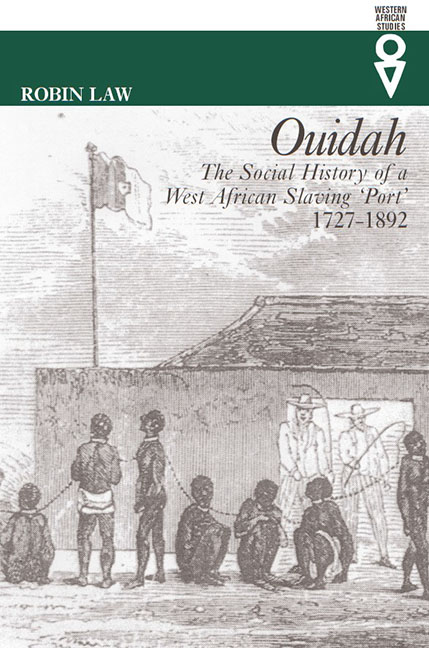Book contents
- Frontmatter
- Dedication
- Contents
- List of Maps & Tables
- Acknowledgements
- Abbreviations
- Map
- Introduction
- 1 Origins: Ouidah before the Dahomian conquest
- 2 The Dahomian Conquest of Ouidah
- 3 Dahomian Ouidah
- 4 The Operation of the Atlantic Slave Trade
- 5 De Souza's Ouidah The era of the illegal slave trade 1815 –39
- 6 The Era of Transition From slaves to palm oil 1840–57
- 7 Dissension & Decline Ouidah under King Glele 1858–77
- 8 From Dahomian to French Rule 1878-92
- Sources & Bibliography
- Index
2 - The Dahomian Conquest of Ouidah
Published online by Cambridge University Press: 25 October 2017
- Frontmatter
- Dedication
- Contents
- List of Maps & Tables
- Acknowledgements
- Abbreviations
- Map
- Introduction
- 1 Origins: Ouidah before the Dahomian conquest
- 2 The Dahomian Conquest of Ouidah
- 3 Dahomian Ouidah
- 4 The Operation of the Atlantic Slave Trade
- 5 De Souza's Ouidah The era of the illegal slave trade 1815 –39
- 6 The Era of Transition From slaves to palm oil 1840–57
- 7 Dissension & Decline Ouidah under King Glele 1858–77
- 8 From Dahomian to French Rule 1878-92
- Sources & Bibliography
- Index
Summary
The political and commercial situation on the Slave Coast was transformed by the rise of Dahomey, under its king Agaja (died 1740), who conquered Allada in 1724 and Hueda in 1727. This profoundly affected Ouidah, which became subject to Dahomey from 1727 and was left as its exclusive outlet for trade with the Europeans after the Dahomians destroyed the rival ‘port’ of Jakin in 1732.The origins of the Hueda–Dahomey war of 1727 have been treated at length elsewhere, and detailed rehearsal would be out of place here; it need only be stated that the general view of contemporary European observers – that Agaja sought control of Ouidah principally in order to secure more effective and unrestricted access to the European trade – remains persuasive. For present purposes, it is the consequences rather than the causes of the war that are of central importance.
The Dahomian forces invaded Hueda in March 1727, and quickly overran it. The capital Savi was taken on 9 March and destroyed; the European factories there, which had survived the initial sack of the town, were burned down by the Dahomians a few days later. Many thousands of the inhabitants of the kingdom were killed or enslaved and sold, and others fled, settling in communities along the coast to both east and west of Ouidah, where the lagoon and other inland waterways afforded a degree of protection against the land-based forces of Dahomey.
There is thus a Hueda quarter, Houedakome, in Porto-Novo, to the east, and a significant Hueda element also settled in Badagry, further east again. The Hueda king Hufon, together with many of his subjects, however, fled westwards, to found the kingdom later known as Hueda-Henji. They first took refuge, as reported immediately after the conquest, on ‘an island on the sea coast … lying near [Grand-] Popoe’. In early 1728 the place where Hufon was residing was named as ‘Topoy’, which may represent ‘Tokpa’, a generic toponym meaning ‘on the waterside’; but ‘Topoy’ was attacked and destroyed by the Dahomians soon after, and Hufon evidently removed to a less accessible site. Hueda tradition indicates that the initial settlement of the exiles was at Mitogbodji, an island in the southwest of Lake Aheme; but Hufon subsequently moved his capital to Houeyogbe, further north, on the western shore of the lake.
- Type
- Chapter
- Information
- OuidahThe Social History of a West African Slaving Port 1727-1892, pp. 50 - 70Publisher: Boydell & BrewerPrint publication year: 2017



